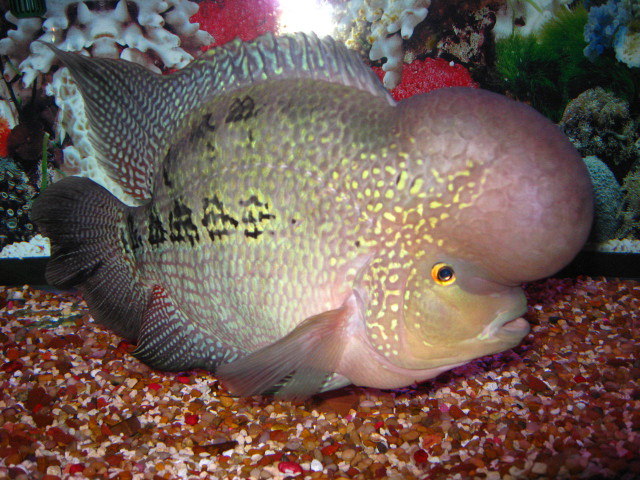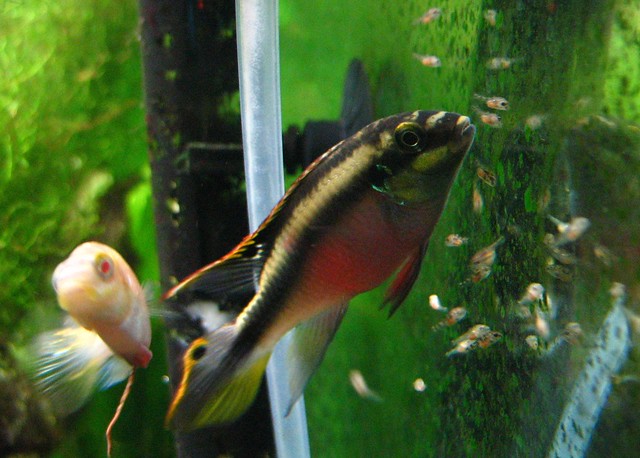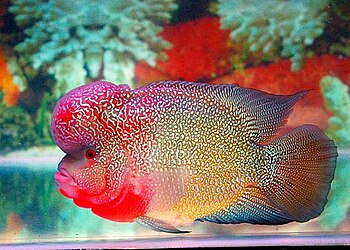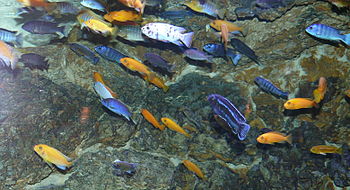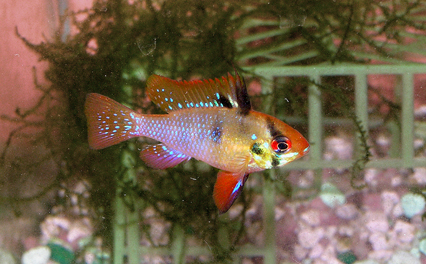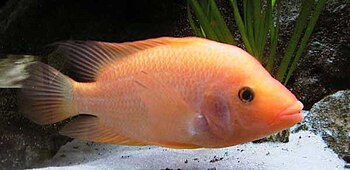 |
| A Picture of my large Blood Parrot (Photo credit: Wikipedia) |
Prevalent speculation points to the following cichlid species as the potential candidates of parental origins; the redhead cichlid (Cichlasoma synspilum) and the Midas cichlid (Amphilophus citrinellus) or a coupling between the red devil cichlid (Amphilophus labiatus) and the severum (Heros Severus). Despite the fact that all of the aforementioned species are native to either Central or South America, the blood parrot is considered an Asian cichlid because of the geographical location of its hybridization.
Regardless of the point of origin or parental ancestry, blood parrot cichlids have stirred up almost as much controversy as their man-made counterparts, the glofish. Unlike the glofish, blood parrots are a product of selective breeding rather than genetic manipulation. As such they have not banned for sale in most countries as a genetically engineered species. The subject of the controversy revolves around the anatomical deformities inherent in the hybridization of this previously nonexistent subspecies.
are a product of selective breeding rather than genetic manipulation. As such they have not banned for sale in most countries as a genetically engineered species. The subject of the controversy revolves around the anatomical deformities inherent in the hybridization of this previously nonexistent subspecies.
Perhaps the most physically detrimental deformity relates to the hybrid's narrow, beak-like mouth. Its vertical mouth opening makes it hard for the fish to feed and leaves it vulnerable to possible starvation. Blood parrots compensate for this deformity by using their throat muscles to finish pulverizing their food. Additional deformities include malformed swim bladders which result in erratic swimming patterns, unnaturally large often misshapen irises and deformed spinal columns that contribute to the fish's unique shape. To add further fuel to the controversy, many breeders inject the fish with colored dyes to increase the intensity and diversity of its color palette and enhance its overall marketability marketing them under the trade name Bubblegum Parrot.
This same practice was also used to transform Indian glassfish into the once very popular Disco fish. The dying of fish for commercial resale is detrimental to the fish's health and frequently shortens their life expectancy. Practical Fishkeeping has been instrumental in exposing these practices to the general public. As a result of many fish stores and online retailers no longer stock the modified variations of these fish.
Although blood parrots were a product of the 80s they were not widely available in pet shops until 2000. Many avid fish enthusiasts were opposed to the sale of these creatures on ethical grounds due to the inherent deformities resulting from their creation. Fish stores who stocked these hybrids were even boycotted. Said boycotts only met with limited success. Some store owners simply cannot afford not to carry this inventory because of the high price tag they fetch. Ethical principles and genetic deformities aside, blood parrots frequently live for 10 years and have been reported to live as long as 15 years of age.
If you are not ethically opposed to owning a blood parrot then you should be aware that this is one of the larger cichlids. Blood parrots commonly grow 8-10 inches in length. A single fish will require a minimum aquarium size of 50 gallons. When kept as a community fish, you will need a substantially larger tank. Care should be exercised when choosing their tank mates. Blood parrots should not be housed with large aggressive fish. They should not be forced to compete for food or turf in a community setting. Angelfish, catfish, danios and larger variety tetras make suitable tank mates.
Blood parrots should be provided with ample room and adequate hiding places so that they can establish their own territorial boundaries. Driftwood, rock work and larger aquarium décor are excellent options. Like many cichlids, these fish are prone to dig up gravel. Choosing a smaller, less course substrate is recommended. These fish tend to function best under subdued lighting. This is attributed to iris irregularities inherent in their breeding.
South American cichlids prefer soft water environments with a ph balance around 6.8. Water temperature should be maintained between 78-86 °F. Lower temperature ranges could result in a loss of coloration.
The blood parrot is an omnivorous cichlid. They will readily accept a wide variety of foods. They are more adept at consuming sinking rather than floating food offerings. Standard food fare can be supplemented with bloodworms and brine shrimp. Commercial products high in b-carotene and canthaxanthin will help enhance and maintain their coloration. These fish are voracious eaters. They are known for generating a large amount of uneaten food debris in a short period of time. A good filtration system combined with frequent water changes and substrate maintenance is a must to keep nitrate levels in check.
Breeding Blood Parrot Cichlids
Although Parrots have been known to mate and even lay eggs, generally they are infertile. Male blood parrots are typically infertile. There have been sporadic cases of successful spawnings, generally when they have been crossed with a non-hybrid fish. The use of a non-hybridized male will increase your rate of success. In commercial breeding, males are injected with hormones to increase fertility rates. Like other cichlids, Blood Parrots will tend the eggs and resulting fry fastidiously. As with any eggs, those that are infertile will turn white and rapidly fungus. The parents will eat infertile eggs to prevent them from spreading the fungus to the fertile eggs.
Once the eggs hatch, daily water changes of 25% are critical to ensuring the health of the fry. Fresh baby brine shrimp are the optimum food during the first couple of weeks. Often pet shops will carry frozen baby brine shrimp, which can also be used. As they fry grow, they can be weaned to finely crushed flake food.
The hottest new trend in aquarium ownership is pet jellyfish. Jellyfish require a specially designed Jellyfish Aquarium Fish Tank to remain alive and healthy. Jellyfish aquariums are easier to maintain than a traditional saltwater tank. Pet Moon Jellyfish have become exceptionally popular in recent years with home aquarists both for their unparalleled elegance and ease of care. The market for moon jellies has increased to the point that two US-based websites are now tank raising these exotic creatures to keep pace with the growing demand. Article Source: EzineArticles |




